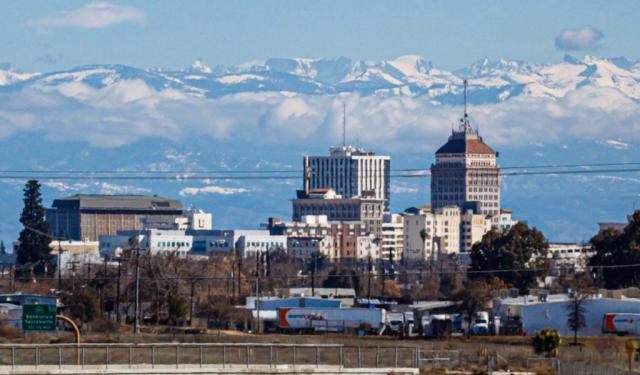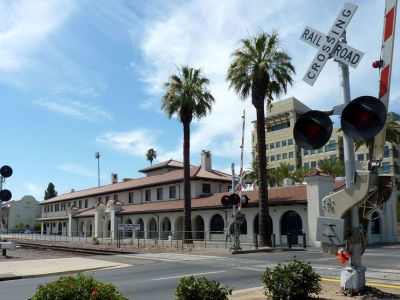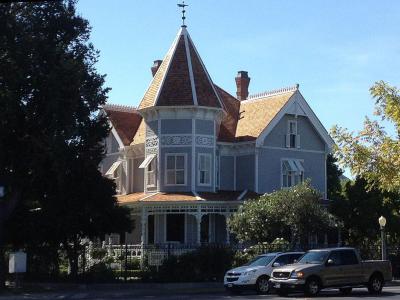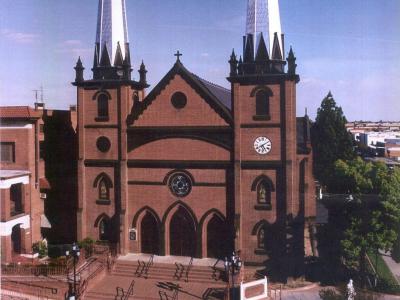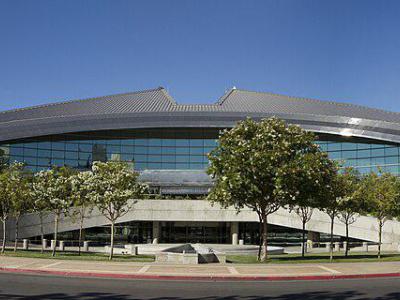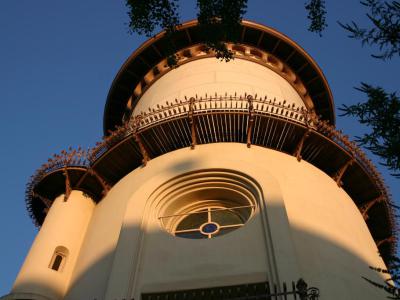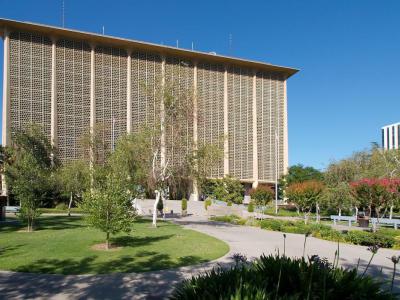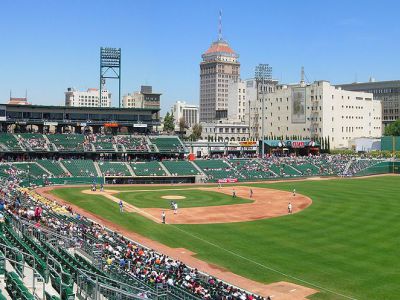Fresno Downtown Walking Tour (Self Guided), Fresno
Nestled in the heart of California's fertile San Joaquin Valley, Fresno is a city rich in history and cultural vibrancy.
The area's first European exploration began in 1772 with the arrival of Pedro Fages, a Spanish soldier and explorer, who later served as the first Lieutenant Governor of the California province. Fresno County, established in 1856 after the California Gold Rush, was named after the ash trees lining the San Joaquin River; the word "Fresno" is the Spanish for "ash."
Fresno's transformation continued with the advent of the Central Pacific Railroad in 1872, which catalyzed the establishment of Fresno Station, incorporated as a city in 1885. The Santa Fe Passenger Depot, an operational train station since 1899, is a testament to Fresno's early significance as a major railway center.
Since the end of the 19th century, Fresno has emerged as a bustling hub, known for its agricultural bounty and as a gateway to the nearby Yosemite, Kings Canyon, and Sequoia National Parks.
Throughout the 20th century, Fresno became a leader in educational innovation and enjoyed a population surge, marking it one of the major urban centers in California. Post World War II, the city saw significant demographic transformations, including the rise of various ethnic neighborhoods. In the 1950s, Fresno played a pivotal role in the development of the credit card industry with the launch of BankAmericard, which evolved into Visa Inc.
While relatively small in terms of size, Fresno, nonetheless, contains several architecturally and historically significant sites, concentrated in its charming Old Town area, that paint a vivid picture of the city's progression over the years.
One of the local historical gems is the Meux Home Museum, a beautifully preserved Victorian mansion, that offers a dive into the domestic life of the late 19th century. Fresno City Hall, a modern architectural feat completed in 1991, contrasts sharply with the historical buildings around it. Just a stone's throw away, the Romanesque-style Old Fresno Water Tower, built in 1894, remains one of the city’s most iconic structures.
Fresno's historical narrative is punctuated by episodes of innovation and change, making it a unique study of American urban development. Today, the city continues to build on its rich historical legacy, balancing modernization with preservation and appreciation of its past. Take this self-guided walk to discover the treasures of Fresno-experience its historical landmarks, enjoy its modern amenities, and embrace the warmth of its community.
The area's first European exploration began in 1772 with the arrival of Pedro Fages, a Spanish soldier and explorer, who later served as the first Lieutenant Governor of the California province. Fresno County, established in 1856 after the California Gold Rush, was named after the ash trees lining the San Joaquin River; the word "Fresno" is the Spanish for "ash."
Fresno's transformation continued with the advent of the Central Pacific Railroad in 1872, which catalyzed the establishment of Fresno Station, incorporated as a city in 1885. The Santa Fe Passenger Depot, an operational train station since 1899, is a testament to Fresno's early significance as a major railway center.
Since the end of the 19th century, Fresno has emerged as a bustling hub, known for its agricultural bounty and as a gateway to the nearby Yosemite, Kings Canyon, and Sequoia National Parks.
Throughout the 20th century, Fresno became a leader in educational innovation and enjoyed a population surge, marking it one of the major urban centers in California. Post World War II, the city saw significant demographic transformations, including the rise of various ethnic neighborhoods. In the 1950s, Fresno played a pivotal role in the development of the credit card industry with the launch of BankAmericard, which evolved into Visa Inc.
While relatively small in terms of size, Fresno, nonetheless, contains several architecturally and historically significant sites, concentrated in its charming Old Town area, that paint a vivid picture of the city's progression over the years.
One of the local historical gems is the Meux Home Museum, a beautifully preserved Victorian mansion, that offers a dive into the domestic life of the late 19th century. Fresno City Hall, a modern architectural feat completed in 1991, contrasts sharply with the historical buildings around it. Just a stone's throw away, the Romanesque-style Old Fresno Water Tower, built in 1894, remains one of the city’s most iconic structures.
Fresno's historical narrative is punctuated by episodes of innovation and change, making it a unique study of American urban development. Today, the city continues to build on its rich historical legacy, balancing modernization with preservation and appreciation of its past. Take this self-guided walk to discover the treasures of Fresno-experience its historical landmarks, enjoy its modern amenities, and embrace the warmth of its community.
How it works: Download the app "GPSmyCity: Walks in 1K+ Cities" from Apple App Store or Google Play Store to your mobile phone or tablet. The app turns your mobile device into a personal tour guide and its built-in GPS navigation functions guide you from one tour stop to next. The app works offline, so no data plan is needed when traveling abroad.
Fresno Downtown Walking Tour Map
Guide Name: Fresno Downtown Walking Tour
Guide Location: USA » Fresno (See other walking tours in Fresno)
Guide Type: Self-guided Walking Tour (Sightseeing)
# of Attractions: 8
Tour Duration: 1 Hour(s)
Travel Distance: 2.3 Km or 1.4 Miles
Author: DanaOffice
Sight(s) Featured in This Guide:
Guide Location: USA » Fresno (See other walking tours in Fresno)
Guide Type: Self-guided Walking Tour (Sightseeing)
# of Attractions: 8
Tour Duration: 1 Hour(s)
Travel Distance: 2.3 Km or 1.4 Miles
Author: DanaOffice
Sight(s) Featured in This Guide:
- Santa Fe Passenger Depot
- Meux Home Museum
- St. John's Cathedral
- Fresno City Hall
- Old Fresno Water Tower
- Courthouse Park
- Fulton Mall
- Chukchansi Park
1) Santa Fe Passenger Depot
The Santa Fe Passenger Depot is an iconic railroad station currently utilized by Amtrak for its San Joaquin passenger train service. Designed by William Benson Storey for the Atchison, Topeka and Santa Fe Railway, the depot mirrors the design of the Stockton – San Joaquin Street Station.
Architecturally, the Santa Fe Railroad Depot is a prime example of the Mission Revival style, characterized by its simple yet elegant design. The station features prominent arches and tile roofs, with many windows framed by segmental arched openings. The roofs, predominantly hipped and of medium pitch, contribute to the station's cohesive aesthetic. A single tower and several turrets, all capped with pyramidal tiled roofs, add to the building's distinctive silhouette. The facade is relatively sparse in terms of sculptural ornamentation, with the most notable decoration being located on the tower on the west elevation.
The station's design focuses on functionality and understated beauty, with its Mission Revival elements creating a timeless look. The few shaped gable ends with curvilinear outlines enhance the depot's architectural interest without overwhelming the overall simplicity. This minimalist approach ensures that the depot remains an elegant and functional structure that has stood the test of time.
Architecturally, the Santa Fe Railroad Depot is a prime example of the Mission Revival style, characterized by its simple yet elegant design. The station features prominent arches and tile roofs, with many windows framed by segmental arched openings. The roofs, predominantly hipped and of medium pitch, contribute to the station's cohesive aesthetic. A single tower and several turrets, all capped with pyramidal tiled roofs, add to the building's distinctive silhouette. The facade is relatively sparse in terms of sculptural ornamentation, with the most notable decoration being located on the tower on the west elevation.
The station's design focuses on functionality and understated beauty, with its Mission Revival elements creating a timeless look. The few shaped gable ends with curvilinear outlines enhance the depot's architectural interest without overwhelming the overall simplicity. This minimalist approach ensures that the depot remains an elegant and functional structure that has stood the test of time.
2) Meux Home Museum (must see)
The Meux Home Museum, originally the family residence of Dr. Thomas Richard Meux, an army surgeon, stands as a testament to the enduring culture and traditions of our city. This heritage structure turned museum has preserved its original features, offering visitors a window into the everyday life of the late 19th century. Step back in time to the romanticized Victorian era with a guided tour through the museum, where costumed guides provide detailed insights into the house's various rooms and former occupants.
Built in 1888, Dr. Meux's 16-room Victorian mansion remains as impressive today as it was over a century ago. The Meux Home pays homage to the architectural and hospitable spirit of the gothic Victorian era. During your visit, you're cordially invited to explore the house through a guided tour and take a leisurely stroll in the picturesque garden.
Tours typically last between 45 minutes to 1 hour, allowing you to immerse yourself in the architecture, artwork, and other treasures from the Victorian Age.
Built in 1888, Dr. Meux's 16-room Victorian mansion remains as impressive today as it was over a century ago. The Meux Home pays homage to the architectural and hospitable spirit of the gothic Victorian era. During your visit, you're cordially invited to explore the house through a guided tour and take a leisurely stroll in the picturesque garden.
Tours typically last between 45 minutes to 1 hour, allowing you to immerse yourself in the architecture, artwork, and other treasures from the Victorian Age.
3) St. John's Cathedral
Saint John's Cathedral serves as the mother church of the Roman Catholic Diocese of Fresno. The parish's origins trace back to 1882, but its story began a few years earlier when Catholic settlers recognized the need for a local church. In 1878, the community started raising funds for this purpose. The Central Pacific Railroad donated two lots, and Bishop Francisco Mora y Borrell of the Diocese of Monterey-Los Angeles purchased two adjacent lots, enabling the construction of the sanctuary, which was completed in November 1880. Initially, the brick structure, featuring a 90-foot steeple, served the five Catholic families in the area.
As the congregation expanded, it outgrew the original church by 1902, prompting plans for a larger building. The cornerstone for the new church was laid on August 3, 1902, and Archbishop George Montgomery dedicated the new sanctuary on June 7, 1903.
The new church, designed by Thomas Bermingham, features a distinctive Gothic-Romanesque style and is constructed of red brick. The facade is notable for its triple entry, flanked by two square towers topped with spires. Above the main entry, a small rose window adds to the architectural elegance of the structure. This design reflects the aspirations and growth of the Catholic community in Fresno at the turn of the 20th century.
Today, the cathedral continues to be a central figure in the spiritual and community life of Fresno, maintaining its importance and relevance over the decades.
As the congregation expanded, it outgrew the original church by 1902, prompting plans for a larger building. The cornerstone for the new church was laid on August 3, 1902, and Archbishop George Montgomery dedicated the new sanctuary on June 7, 1903.
The new church, designed by Thomas Bermingham, features a distinctive Gothic-Romanesque style and is constructed of red brick. The facade is notable for its triple entry, flanked by two square towers topped with spires. Above the main entry, a small rose window adds to the architectural elegance of the structure. This design reflects the aspirations and growth of the Catholic community in Fresno at the turn of the 20th century.
Today, the cathedral continues to be a central figure in the spiritual and community life of Fresno, maintaining its importance and relevance over the decades.
4) Fresno City Hall
Fresno City Hall is a striking example of Post-modern Futurist architecture. Designed by the renowned Canadian architect Arthur Erickson in 1991, this building serves as the seat of the city government and the office of the mayor. Erickson, known for other notable works such as One California Plaza in Los Angeles and the Embassy of Canada in Washington, D.C., created a building that stands out as a masterpiece of modern design. Fresno City Hall anchors the northern end of the "Mariposa Mall," a twelve-block civic corridor that concludes with the Fresno County Courthouse to the south.
The building’s exterior is characterized by its post-modern futurist style, featuring dull-finished stainless steel and glass panels. The angular roofline is designed to evoke the peaks of the nearby Sierra Nevada mountains, creating a dynamic contrast with the more historic structures in downtown Fresno. This modern aesthetic has sparked some controversy, yet it is widely recognized as a brilliant piece of architecture. The five-story structure includes a variety of city offices, with the central interior space dedicated to the council chamber, which seats 249 people and benefits from natural light streaming through a skylight situated between the two peaks of the roof.
Beyond its functional aspects, Fresno City Hall includes notable exterior features, such as a large fountain located between the dual stairways that lead up to the main public entrance.
Fresno City Hall also has a place in popular culture, having been used as a filming location for the 1994 science-fiction movie "The Puppet Masters," where its exterior doubled as Des Moines City Hall.
The building’s exterior is characterized by its post-modern futurist style, featuring dull-finished stainless steel and glass panels. The angular roofline is designed to evoke the peaks of the nearby Sierra Nevada mountains, creating a dynamic contrast with the more historic structures in downtown Fresno. This modern aesthetic has sparked some controversy, yet it is widely recognized as a brilliant piece of architecture. The five-story structure includes a variety of city offices, with the central interior space dedicated to the council chamber, which seats 249 people and benefits from natural light streaming through a skylight situated between the two peaks of the roof.
Beyond its functional aspects, Fresno City Hall includes notable exterior features, such as a large fountain located between the dual stairways that lead up to the main public entrance.
Fresno City Hall also has a place in popular culture, having been used as a filming location for the 1994 science-fiction movie "The Puppet Masters," where its exterior doubled as Des Moines City Hall.
5) Old Fresno Water Tower
The Old Fresno Water Tower is an iconic example of American Romanesque architecture. Standing at 109 feet tall, this historic structure was designed by Chicago architect George Washington Maher and completed in 1894. The water tower boasts a storage capacity of 250,000 gallons, housed within its tank. Constructed of red brick, each layer tapers to create a beehive effect. The tower features a robust two-foot-thick inner wall and an outer wall approximately fourteen inches thick, with a three-foot-wide hollow space between them. The exterior brickwork is painted, enhancing its visual appeal.
Originally, the design included plans for three floors beneath the water tank; however, only the second floor was completed, and it was later removed. Despite these changes, the water tower’s unique structure and purpose have cemented its status as a significant architectural and historical landmark in Fresno. The tower served the city until 1963, when advances in pumping technology rendered its machinery obsolete.
Throughout its history, the Old Fresno Water Tower has undergone various functional transformations. While the original design envisioned a library on the upper floors, this plan was never realized. Instead, the first floor was repurposed as a parking meter repair facility for several years. In 2001, significant renovations were undertaken to repurpose the interior of the tower into a visitors' center for the City and County of Fresno. This remodeling included the removal of the second floor and the creation of a landscaped plaza and a separate restroom building adjacent to the tower.
Originally, the design included plans for three floors beneath the water tank; however, only the second floor was completed, and it was later removed. Despite these changes, the water tower’s unique structure and purpose have cemented its status as a significant architectural and historical landmark in Fresno. The tower served the city until 1963, when advances in pumping technology rendered its machinery obsolete.
Throughout its history, the Old Fresno Water Tower has undergone various functional transformations. While the original design envisioned a library on the upper floors, this plan was never realized. Instead, the first floor was repurposed as a parking meter repair facility for several years. In 2001, significant renovations were undertaken to repurpose the interior of the tower into a visitors' center for the City and County of Fresno. This remodeling included the removal of the second floor and the creation of a landscaped plaza and a separate restroom building adjacent to the tower.
6) Courthouse Park
Courthouse Park has been a hub of community activity since the 1870s. In 1872, the Central Pacific Railroad laid out the town site of Fresno Station and donated four blocks at Mariposa and "L" Streets for a future courthouse and park. By 1874, the county seat moved from Millerton to Fresno, solidifying Courthouse Park as the center of county government. This historic park is home to several notable attractions, including the Fresno County Courthouse, the Old Fresno Water Tower, and the Fresno County War Memorial, offering visitors a rich tapestry of history, architecture, and leisure opportunities.
One of the main draws of Courthouse Park is the Fresno County Courthouse, built in 1910 and listed on the National Register of Historic Places. This stunning example of Beaux-Arts architecture features a grand entrance with four Ionic columns and a large dome, symbolizing the judicial authority and civic pride of Fresno. Visitors can tour the courthouse to appreciate its architectural grandeur and historical significance or admire its impressive facade from the park's verdant lawns.
Another iconic structure within Courthouse Park is the Old Fresno Water Tower, constructed in 1894. This 109-foot tall tower, designed in the American Romanesque style, is one of Fresno's most recognizable landmarks. Visitors can climb to the top for panoramic views of the surrounding area, further enhancing their appreciation of Fresno's historical landscape.
Courthouse Park also honors local veterans through the Fresno County War Memorial. This poignant memorial features a series of granite walls inscribed with the names of men and women from the county who have served in the armed forces. Accompanying these walls are bronze sculptures depicting soldiers in action, creating a powerful tribute to the bravery and sacrifice of local veterans. The memorial provides a place for reflection and remembrance amidst the park's serene environment.
One of the main draws of Courthouse Park is the Fresno County Courthouse, built in 1910 and listed on the National Register of Historic Places. This stunning example of Beaux-Arts architecture features a grand entrance with four Ionic columns and a large dome, symbolizing the judicial authority and civic pride of Fresno. Visitors can tour the courthouse to appreciate its architectural grandeur and historical significance or admire its impressive facade from the park's verdant lawns.
Another iconic structure within Courthouse Park is the Old Fresno Water Tower, constructed in 1894. This 109-foot tall tower, designed in the American Romanesque style, is one of Fresno's most recognizable landmarks. Visitors can climb to the top for panoramic views of the surrounding area, further enhancing their appreciation of Fresno's historical landscape.
Courthouse Park also honors local veterans through the Fresno County War Memorial. This poignant memorial features a series of granite walls inscribed with the names of men and women from the county who have served in the armed forces. Accompanying these walls are bronze sculptures depicting soldiers in action, creating a powerful tribute to the bravery and sacrifice of local veterans. The memorial provides a place for reflection and remembrance amidst the park's serene environment.
7) Fulton Mall
Fulton Mall is a pedestrian mall and urban park that was established in 1964 by excluding vehicular traffic from six blocks of Fulton Street, along with portions of three intersecting streets. The mall was designed as the centerpiece of a transformative plan for Fresno’s downtown area by Victor Gruen and Associates, with Garrett Eckbo, a noted landscape architect, responsible for the modernist landscape design. Despite its initial popularity, Fulton Mall faced challenges due to the city's suburban expansion and the opening of the Fashion Fair Mall six miles to the north.
Fulton Street, originally known as J Street, has been a main corridor for business activity since Fresno's inception. The street saw the construction of several notable buildings, including the 10-story Helm Building in 1914, known as Fresno's first skyscraper, and the locally-founded Gottschalks department store. Other significant structures on Fulton Street include the 8-story Bank of Italy building (1918), the Rustigian Building (1920), the Radin-Kamp Department Store (1924), the San Joaquin Light and Power Corporation Building, and the Warnors Theater, both from the 1920s.
The design of Fulton Mall was part of an early example of the masterplan-oriented thought process pioneered by Victor Gruen, whose ideas influenced the development of shopping malls across the United States. The mall's creation aimed to convert Fulton Street into a high-quality, dense activity pedestrian mall, reflecting Eckbo's modernist landscape design ethos. The area was adorned with sculptures by renowned artists, including "The Visit" by Clement Renzi, "Aquarius Ovoid" by George Tsutakawa, and the rare "Washer Woman" sculpture by Pierre-Auguste Renoir, one of only six original bronze castings in the world.
Despite its historical and architectural significance, the Fulton Mall experienced a decline as Fresno expanded outward, drawing businesses and shoppers to suburban locations. However, the mall remains a testament to mid-20th-century urban planning and design, featuring a rich collection of public art and significant historical buildings that continue to be points of interest in downtown Fresno.
Fulton Street, originally known as J Street, has been a main corridor for business activity since Fresno's inception. The street saw the construction of several notable buildings, including the 10-story Helm Building in 1914, known as Fresno's first skyscraper, and the locally-founded Gottschalks department store. Other significant structures on Fulton Street include the 8-story Bank of Italy building (1918), the Rustigian Building (1920), the Radin-Kamp Department Store (1924), the San Joaquin Light and Power Corporation Building, and the Warnors Theater, both from the 1920s.
The design of Fulton Mall was part of an early example of the masterplan-oriented thought process pioneered by Victor Gruen, whose ideas influenced the development of shopping malls across the United States. The mall's creation aimed to convert Fulton Street into a high-quality, dense activity pedestrian mall, reflecting Eckbo's modernist landscape design ethos. The area was adorned with sculptures by renowned artists, including "The Visit" by Clement Renzi, "Aquarius Ovoid" by George Tsutakawa, and the rare "Washer Woman" sculpture by Pierre-Auguste Renoir, one of only six original bronze castings in the world.
Despite its historical and architectural significance, the Fulton Mall experienced a decline as Fresno expanded outward, drawing businesses and shoppers to suburban locations. However, the mall remains a testament to mid-20th-century urban planning and design, featuring a rich collection of public art and significant historical buildings that continue to be points of interest in downtown Fresno.
8) Chukchansi Park
Chukchansi Park, formerly known as Grizzlies Stadium, is a city-owned baseball stadium in Fresno, completed in 2002 as the home for the Pacific Coast League's Fresno Grizzlies. The first game at the stadium took place on May 1, 2002. In September 2006, Chukchansi Gold Resort & Casino, affiliated with the Chukchansi tribe, became the premier corporate sponsor for the stadium through a 15-year, $16 million deal.
The stadium was designed by Populous, previously known as HOK Sport, a firm renowned for designing many modern sports stadiums such as Oriole Park at Camden Yards, PETCO Park, and Comerica Park. The $46 million facility seats 12,500 people and features field dimensions of 324 feet for left field, 402 feet for center field, and 335 feet for right field.
Chukchansi Park's current tenants include the Fresno Grizzlies of the Pacific Coast League, who have called the stadium home since 2002, and the Fresno Fuego of the USL Premier Development League, who have been tenants since 2007. Beyond baseball, the stadium hosts a variety of events including soccer matches, music concerts, motocross events, and high school football games, making it a versatile and important venue in Fresno's sports and entertainment landscape.
The stadium was designed by Populous, previously known as HOK Sport, a firm renowned for designing many modern sports stadiums such as Oriole Park at Camden Yards, PETCO Park, and Comerica Park. The $46 million facility seats 12,500 people and features field dimensions of 324 feet for left field, 402 feet for center field, and 335 feet for right field.
Chukchansi Park's current tenants include the Fresno Grizzlies of the Pacific Coast League, who have called the stadium home since 2002, and the Fresno Fuego of the USL Premier Development League, who have been tenants since 2007. Beyond baseball, the stadium hosts a variety of events including soccer matches, music concerts, motocross events, and high school football games, making it a versatile and important venue in Fresno's sports and entertainment landscape.
Walking Tours in Fresno, California
Create Your Own Walk in Fresno
Creating your own self-guided walk in Fresno is easy and fun. Choose the city attractions that you want to see and a walk route map will be created just for you. You can even set your hotel as the start point of the walk.
Historical Buildings Walking Tour
Fresno, California, boasts a variety of historical buildings that reflect its growth from a small agricultural community to a bustling city. Collectively, these buildings preserve Fresno's past but also contribute to its vibrant urban fabric, blending historical significance with modern vitality.
The Meux Home Museum, an elegant Victorian mansion, offers a glimpse into 19th-century life... view more
Tour Duration: 2 Hour(s)
Travel Distance: 3.7 Km or 2.3 Miles
The Meux Home Museum, an elegant Victorian mansion, offers a glimpse into 19th-century life... view more
Tour Duration: 2 Hour(s)
Travel Distance: 3.7 Km or 2.3 Miles
The Most Popular Cities
/ view all
